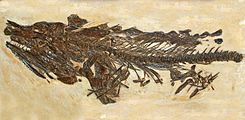Cimolichthys
Appearance
| Cimolichthys Temporal range: Late Cretaceous[1]
| |
|---|---|

| |
| Cimolichthys nepaholica specimen, Denver museum. | |
| Scientific classification | |
| Kingdom: | |
| Phylum: | |
| Class: | |
| Order: | Rosen, 1973
|
| Suborder: | |
| Family: | Cimolichthyidae[2]
|
| Genus: | Cimolichthys Leidy, 1857
|
| Species | |
| |
Cimolichthys is an extinct genus of 1.5- to 2.0-meter-long nektonic predatory aulopiformid fish.
Description
Although the closest living relatives of Cimolichthys are lancetfish and lizardfish, the living animals would have resembled very large freshwater pikes. Their bodies were covered by large, heavy scutes. Typical of this species are narrow lower jaws with several series of teeth. Remains of undigested fishes or squids have been found in collected specimens. They lived in the Late Cretaceous period, from the Cenomanian age (99.6 ± 0.9 Mya and 93.5 ± 0.8 Mya) to the Maastrichtian age (70.6 ± 0.6 Mya to 66 Mya). [3]
Distribution
Fossils of Cimolichthys are found in Cretaceous strata of North America (Canada and United States) and Europe.
Gallery
-
Cimolichthys at the Canadian Museum of Nature, Ottawa
References
- ^ Paleobiology Database
- ^ Silva, Hilda, and Valéria Gallo. "Taxonomic review and phylogenetic analysis of Enchodontoidei (Teleostei: Aulopiformes)." Anais da Academia Brasileira de Ciências 83.2 (2011): 483-511.
- ^ Cimolichthys nepaholica at Oceans of Kansas
- Sepkoski, Jack Sepkoski's Online Genus Database

